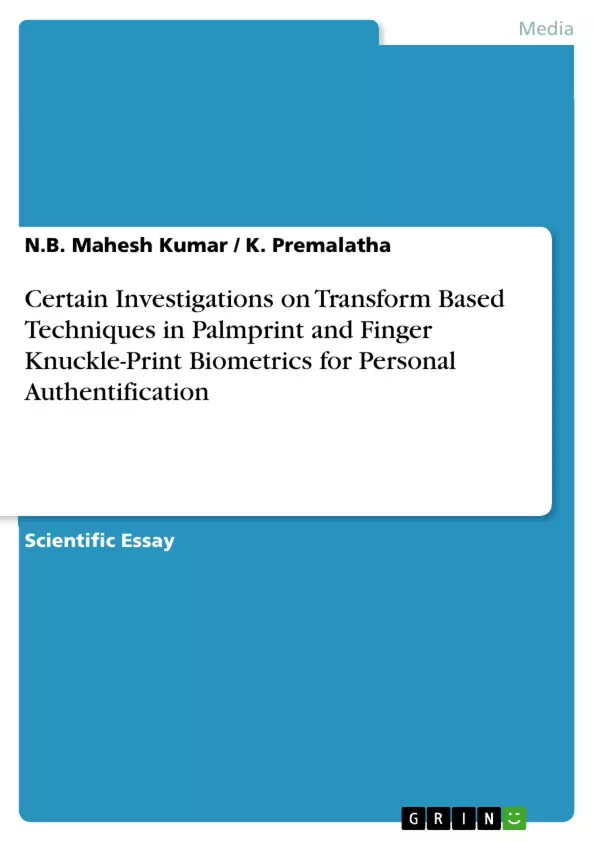Biometric methods for authenticating and identifying people are increasingly used in both the commercial and private sector. Today’s commercially available biometric systems show good reliability. However, they generally lack user acceptance. Users showed an antipathy towards touching a possibly dirty fingerprint scanner, or looking into an iris scanner that might malfunction and eventually impair their vision. Whether those fears are well founded or not is less important. The fact is, they have considerable influence on user acceptance. And user consent is important for a good and successful application of a biometric system, as well as for good recognition rates.
In response to the increasing demand for reliable as well as user friendly biometric systems, this work investigates the applicability of palmprint and FKP were the biometric features for authentication. Using palmprint or FKP as a biometric system avoids such problems as shown before, since it requires no subject interaction.
The main objectives of the thesis are: to propose the transform based techniques that is used to achieve higher recognition accuracy and lower equal error rate; and to examine the performance of the proposed techniques with the existing methodologies.
Inhaltsverzeichnis (Table of Contents)
- INTRODUCTION TO BIOMETRICS
- INTRODUCTION
- PALMPRINT BIOMETRICS
- FINGER KNUCKLE- PRINT BIOMETRICS
- PROS OF FINGER KNUCKLE-PRINT AND PALMPRINT
- LOCAL AND GLOBAL FEATURES
- PROBLEM STATEMENT
- MOTIVATION
- OBJECTIVES
- BIOMETRIC DATASETS
- PERFORMANCE METRICS
- LOCAL AND GLOBAL FEATURE EXTRACTION USING WINDOW WIDTH OPTIMIZED STOCKWELL TRANSFORM IN PALMPRINT BIOMETRIC SYSTEM
- OVERVIEW OF WINDOW WIDTH OPTIMIZED S-TRANSFORM
- LOCAL GLOBAL FEATURE EXTRACTION - AND MATCHING
- LOCAL GLOBAL FEATURE FUSION FOR PALMPRINT RECOGNITION
- EXPERIMENTAL RESULTS AND DISCUSSION
- SUMMARY
- CONCLUSIONS
Zielsetzung und Themenschwerpunkte (Objectives and Key Themes)
This work explores the application of the Window Width Optimized Stockwell Transform (WWOST) for palmprint authentication. It aims to demonstrate the efficacy of WWOST in extracting both local and global features from palmprint images, ultimately achieving improved accuracy in palmprint recognition systems. The study investigates the effectiveness of this approach in comparison to existing techniques.
- Palmprint Biometrics
- Local and Global Feature Extraction
- Window Width Optimized Stockwell Transform (WWOST)
- Palmprint Recognition Accuracy
- Performance Evaluation and Comparison
Zusammenfassung der Kapitel (Chapter Summaries)
- Chapter 1: Introduction to Biometrics
- Introduces the field of biometrics and its applications.
- Explains the concept of palmprint biometrics and finger knuckle-print biometrics.
- Discusses preprocessing and ROI extraction for palmprint and finger knuckle-print biometrics.
- Outlines the advantages of finger knuckle-print and palmprint biometrics.
- Describes the characteristics of local and global features.
- Presents the problem statement, motivation, and objectives of the study.
- Reviews available biometric datasets including the COEP palmprint dataset, PolyU palmprint dataset, IIT Delhi Touchless Palmprint dataset, and PolyU Finger Knuckle-print dataset.
- Explains performance metrics such as False Acceptance Rate (FAR), False Rejection Rate (FRR), Equal Error Rate (EER), Correct Classification Rate (CCR), and Receiver Operating Characteristic (ROC) curve.
- Chapter 2: Local and Global Feature Extraction using Window Width Optimized Stockwell Transform in Palmprint Biometric System
- Provides an overview of the Window Width Optimized S-Transform (WWOST) algorithm.
- Explains the process of local and global feature extraction using WWOST.
- Details the methods for local and global feature matching, including phase-only correlation and band-limited phase-only correlation.
- Presents a fusion approach for combining local and global features to enhance palmprint recognition.
- Discusses experimental results, performance analysis, and a comparison with existing methods.
Schlüsselwörter (Keywords)
Palmprint biometrics, Finger knuckle-print biometrics, Window Width Optimized Stockwell Transform (WWOST), Local and global feature extraction, Palmprint recognition, Feature fusion, Performance evaluation, False Acceptance Rate (FAR), False Rejection Rate (FRR), Equal Error Rate (EER), Correct Classification Rate (CCR), Receiver Operating Characteristic (ROC) curve.
- Arbeit zitieren
- N.B. Mahesh Kumar (Autor:in), K. Premalatha (Autor:in), 2016, Certain Investigations on Transform Based Techniques in Palmprint and Finger Knuckle-Print Biometrics for Personal Authentification, München, GRIN Verlag, https://www.grin.com/document/378795



